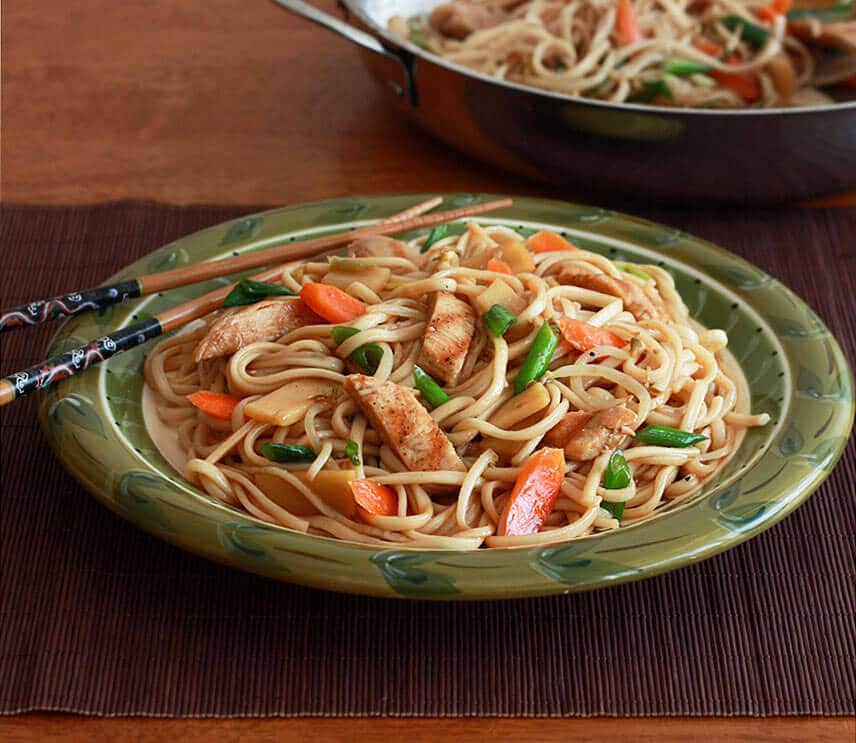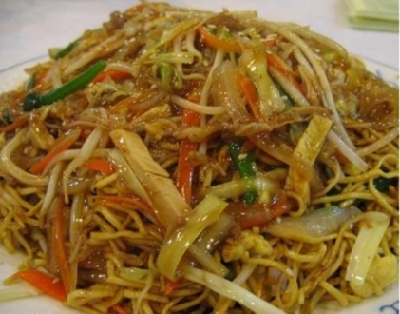Source(google.com.pk)
The Chinese believe that every meal should contain an equal division between fan, grains and starches, and t'sai, fruits and vegetables. One of the grains they rely on to provide this harmonious dietary balance is noodles.
Whether you slurp them, gulp them down, or twirl them on your fork, everyone seems to love noodles. Nearly all cultures have at least one cherished noodle dish, from German Spaetzle (homemade noodles with egg), to Jewish Kreplachs - noodle pastries filled with beef, chicken and spices. But only the Italians rival China for the title of the culture most devoted to noodles. (For more information on Italian pasta, check out this excellent article by Kyle Phillips, About's Guide to Italian Food).
There is some dispute over who originally came up with the idea of mixing water and flour to create noodles. The Arabs claim to have been the first to use dried pasta, as a means of preserving flour during their forays across the desert. But regardless of their origin, we do know that the Chinese have been feasting on noodles for approximately 2000 years, since the Han dynasty (206 BC - 220 AD). In fact, some experts believe that the Italians got their first taste of pasta when Marco Polo returned home from his long trek across China with a host of exotic food items, including noodles.
Like Italian pasta, Asian noodles vary in width - they can be thick as coffee stir sticks or thin as toothpicks. When it comes to length, however, they are usually served long and uncut. This is because long noodles symbolize a long life in Chinese tradition. Noodles are commonly served at birthday celebrations, and fresh noodles are regularly placed at gravesites.
Types of Noodles
Chinese noodles, known collectively as mien, fall into three main categories. The most common are wheat flour noodles, which can be made with or without eggs. While today wheat flour noodles are enjoyed throughout China, they originated in the north, where wheat is a staple crop. Depending on the remaining ingredients, wheat noodles can be white or yellow, thin as spaghetti or thick as fettucine, stiff or extremely elastic.
Made from rice flour, water, and salt, rice noodles can also be thick or very thin, the latter almost resembling long strings of coconut. The same is true of rice sticks. There are also rice paper wrappers which come in either circular or triangular shape. Finally, cellophane noodles are clear noodles made from ground mung bean paste.
In China, making "hand-pulled" noodles is an art involving holding the stretched out paste in both hands and whirling it around several times. Then the paste is laid out on a board and folded and refolded repeatedly. Eventually the paste is transformed into long, thin, noodles. While in China it is still possible to watch vendors make hand-pulled noodles, today most noodles are made by machine.
How to Enjoy Noodles
Noodles are eaten hot or cold, steamed, stir-fried, deep-fried, boiled, or served in a soup. For the nutritionally-inclined, noodles are an excellent source of protein. Besides being low in calories, they are extremely high in complex carbohydrates.
Readers often ask me to explain the difference between lo mein and chow mein noodles. Actually, the difference between the two lies not in the type of noodles used, but in the way the two dishes are prepared. In the case of chow mein, the ingredients are stir-fried and then served over noodles that have been prepared separately. By contrast, lo mein involves tossing boiled noodles in the wok and mixing them with other ingredients during the final stages of cooking. This allows the noodles to pick up more of the sauce flavor.
There's no hard and fast rules about what type of noodles to use with either dish. (In fact, you'll often find chow mein recipes that substitute rice for the noodles). In the west, it is customary to use crisp noodles when preparing chow mein, while in China chow mein is made with soft noodles. Meanwhile, Italian pastas such as fettuccine or spaghetti work quite well in lo mein recipes. However, theoretically you could use the same noodles to prepare either one.
There is some dispute over who originally came up with the idea of mixing water and flour to create noodles. The Arabs claim to have been the first to use dried pasta, as a means of preserving flour during their forays across the desert. But regardless of their origin, we do know that the Chinese have been feasting on noodles for approximately 2000 years, since the Han dynasty (206 BC - 220 AD). In fact, some experts believe that the Italians got their first taste of pasta when Marco Polo returned home from his long trek across China with a host of exotic food items, including noodles.
Like Italian pasta, Asian noodles vary in width - they can be thick as coffee stir sticks or thin as toothpicks. When it comes to length, however, they are usually served long and uncut. This is because long noodles symbolize a long life in Chinese tradition. Noodles are commonly served at birthday celebrations, and fresh noodles are regularly placed at gravesites.
Types of Noodles
Chinese noodles, known collectively as mien, fall into three main categories. The most common are wheat flour noodles, which can be made with or without eggs. While today wheat flour noodles are enjoyed throughout China, they originated in the north, where wheat is a staple crop. Depending on the remaining ingredients, wheat noodles can be white or yellow, thin as spaghetti or thick as fettucine, stiff or extremely elastic.
Made from rice flour, water, and salt, rice noodles can also be thick or very thin, the latter almost resembling long strings of coconut. The same is true of rice sticks. There are also rice paper wrappers which come in either circular or triangular shape. Finally, cellophane noodles are clear noodles made from ground mung bean paste.
In China, making "hand-pulled" noodles is an art involving holding the stretched out paste in both hands and whirling it around several times. Then the paste is laid out on a board and folded and refolded repeatedly. Eventually the paste is transformed into long, thin, noodles. While in China it is still possible to watch vendors make hand-pulled noodles, today most noodles are made by machine.
How to Enjoy Noodles
Noodles are eaten hot or cold, steamed, stir-fried, deep-fried, boiled, or served in a soup. For the nutritionally-inclined, noodles are an excellent source of protein. Besides being low in calories, they are extremely high in complex carbohydrates.
Readers often ask me to explain the difference between lo mein and chow mein noodles. Actually, the difference between the two lies not in the type of noodles used, but in the way the two dishes are prepared. In the case of chow mein, the ingredients are stir-fried and then served over noodles that have been prepared separately. By contrast, lo mein involves tossing boiled noodles in the wok and mixing them with other ingredients during the final stages of cooking. This allows the noodles to pick up more of the sauce flavor.
There's no hard and fast rules about what type of noodles to use with either dish. (In fact, you'll often find chow mein recipes that substitute rice for the noodles). In the west, it is customary to use crisp noodles when preparing chow mein, while in China chow mein is made with soft noodles. Meanwhile, Italian pastas such as fettuccine or spaghetti work quite well in lo mein recipes. However, theoretically you could use the same noodles to prepare either one.
Chinese Noodles Recipe Chinese Recipes With Chicken by Chef Zakir For Kids Soup Images In Urdu Chicken Shashlik Bitter Gourd Urdu Fish Authentic

Chinese Noodles Recipe Chinese Recipes With Chicken by Chef Zakir For Kids Soup Images In Urdu Chicken Shashlik Bitter Gourd Urdu Fish Authentic

Chinese Noodles Recipe Chinese Recipes With Chicken by Chef Zakir For Kids Soup Images In Urdu Chicken Shashlik Bitter Gourd Urdu Fish Authentic

Chinese Noodles Recipe Chinese Recipes With Chicken by Chef Zakir For Kids Soup Images In Urdu Chicken Shashlik Bitter Gourd Urdu Fish Authentic

Chinese Noodles Recipe Chinese Recipes With Chicken by Chef Zakir For Kids Soup Images In Urdu Chicken Shashlik Bitter Gourd Urdu Fish Authentic

Chinese Noodles Recipe Chinese Recipes With Chicken by Chef Zakir For Kids Soup Images In Urdu Chicken Shashlik Bitter Gourd Urdu Fish Authentic

Chinese Noodles Recipe Chinese Recipes With Chicken by Chef Zakir For Kids Soup Images In Urdu Chicken Shashlik Bitter Gourd Urdu Fish Authentic

Chinese Noodles Recipe Chinese Recipes With Chicken by Chef Zakir For Kids Soup Images In Urdu Chicken Shashlik Bitter Gourd Urdu Fish Authentic

Chinese Noodles Recipe Chinese Recipes With Chicken by Chef Zakir For Kids Soup Images In Urdu Chicken Shashlik Bitter Gourd Urdu Fish Authentic

Chinese Noodles Recipe Chinese Recipes With Chicken by Chef Zakir For Kids Soup Images In Urdu Chicken Shashlik Bitter Gourd Urdu Fish Authentic

Chinese Noodles Recipe Chinese Recipes With Chicken by Chef Zakir For Kids Soup Images In Urdu Chicken Shashlik Bitter Gourd Urdu Fish Authentic
No comments:
Post a Comment